
Singapore, May 31, 2025 – In a powerful speech at the Shangri-La Dialogue, the U.S.
. Defense Secretary Pete Hegseth asserted that the United States stands ready to “fight and win” against any Chinese military hostility, particularly in the Indo-Pacific area. His address conveyed a definite message: America is not stepping back from its leadership position in the area, and it anticipates its allies to remain resolute, boost defense expenditures, and prepare for a changing security environment.
Addressing a distinguished gathering of defense ministers, generals, and strategists from Asia and beyond, Hegseth presented a strategic plan aimed at countering China’s growing military assertiveness, especially in relation to Taiwan, the South China Sea, and cyber warfare. He said plainly:
“The danger posed by China is not theoretical — it is tangible, and it may be approaching.”
Hegseth referenced satellite intelligence, Chinese military exercises simulating blockades and attacks on Taiwan, and Beijing’s heightened deployment of naval forces in disputed waters.
Crucial Choices and Challenges
The most prominent part of the address was a clear appeal to America’s Indo-Pacific allies — such as Japan, South Korea, the Philippines, Australia, and India — to increase their defense spending and expedite the modernization of their military forces.
Hegseth promoted a “5% Defense Threshold,” urging allies to dedicate at least 5% of their GDP to defense, indicating a proposed adjustment in NATO’s updated spending guidelines.
He furthermore declared various strategic commitments of the U.S.:
Increase in collaborative naval exercises in the South China Sea.
Installation of sophisticated missile defense systems in Guam and the Philippines.
Enhanced collaborations for sharing intelligence with Southeast Asian nations.
Assistance to Taiwan via defensive systems without combat and cyber collaboration.
Participants Involved
The discussion was joined by leading defense representatives from more than 40 countries, including:
Ng Eng Hen, Singapore’s Minister of Defense.
Yasukazu Hamada, the Minister of Defense for Japan.
Rajnath Singh, India’s Defense Minister
Pete Hegseth, followed by Lloyd Austin, is making his initial major global appearance.
The Chinese delegation, headed by General Liu Zhenli, strongly condemned Hegseth’s speech, labeling it “Cold War-style intimidation.”
Regardless of China’s protests, multiple regional officials privately supported Hegseth’s stance, mentioning worries about Chinese military expansion on artificial islands and the economic pressure endured by nations such as the Philippines and Vietnam.
Strategic Results
Although no official agreements were made, several bilateral and trilateral discussions took place on the margins of the event. Main results included:
Japan and Australia came to a consensus to collaborate on the development of drone surveillance technologies.
The Philippines asked for U.S. logistical assistance and radar technology to oversee its maritime borders.
South Korea has suggested a Pan-Pacific Cyber Defense Initiative, which will be further discussed in the third quarter of 2025.

A joint statement released by the U.S., Japan, and Australia emphasized a dedication to upholding “freedom of navigation, territorial integrity, and defense transparency.”
Importance of the Issue
China’s defense expenditures have increased at a double-digit pace for more than ten years. It currently possesses the largest navy globally by ship count, and its missile and cyber capabilities compete with those of any major power. Hegseth’s caution isn’t aimed at inciting conflict — it’s focused on avoiding it via power and collective regional accountability.
Smaller countries such as Malaysia, Vietnam, and Indonesia continue to be cautious about taking sides. However, U.S. officials are discreetly establishing connections, providing training initiatives, equipment enhancements, and economic support to gain influence.
Final thoughts
The Shangri-La Dialogue 2025 was a key event in U.S.-Asia defense strategy.Secretary Hegseth’s address marks a change in America’s role in the Indo-Pacific — evolving from simple presence to targeted coalition-building and strategic deterrence.
His last comment encapsulated the stakes:
“Silence cannot sustain peace.” It must be upheld — collectively — through readiness, through collaboration, and through intent.”
With China’s growth in influence, the region is confronted with a clear decision: establish collective security or risk navigating the future independently


